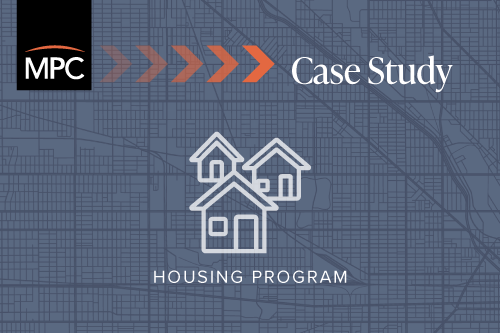Renters Organizing Ourselves to Stay (ROOTS) Initiative
Chicago, Cook County
Housing Program

Program background
As the Albany Park neighborhood of Chicago and other northwest side communities struggled to recover from the foreclosure crisis, the market was ripe for outside investors to buy up rental properties in 2–4 unit buildings. For community residents and local organizations concerned about preserving affordable housing and the pressures of neighborhood change, this was a warning sign. High-end developments started to pop up in place of housing that was traditionally affordable, and multi-unit rental buildings were increasingly being converted to single-family homes.
Determined to fight back against the loss of affordability in the neighborhood, Communities United (CU) began convening local residents who wanted to remain in the area and were interested in developing a plan to preserve and create more affordable housing options. From these meetings, the Renters Organizing Ourselves to Stay (ROOTS) initiative was born. ROOTS is a unique collaboration between Communities United, Enterprise Community Partners (Enterprise), the Chicago Metropolitan Housing Development Corporation (CMHDC), and the Cook County Land Bank Authority (CCLBA).
How it works
Through the ROOTS campaign, CU decided to focus their efforts on foreclosed 2-4 unit properties, with the intention of preserving them as long-term affordable rentals. Without access to capital in an ever-tightening housing market, CU and the residents involved in ROOTS realized that they could not be competitive in moving their plan forward. CU decided to partner with Enterprise, which provided a $5 million line of credit to help the campaign move forward with acquisition, and CMHDC, which served as the developer to acquire, rehab and manage the properties. Properties were acquired using a combination of cash equity and the line of credit, and permanent financing was brought in after the renovation of a property was complete.
The on-the-ground organizing was a very important component of ROOTS’ success. Connecting with renters living in foreclosed properties was integral in helping Enterprise and CMHDC to understand neighborhood dynamics and advance the project forward. By conducting research on foreclosed properties, CU discovered that Fannie Mae was the largest holder of foreclosed 2–4 unit properties in Albany Park, owning about 40% of foreclosed buildings in the community. Residents began appealing to their elected officials to put pressure on Fannie Mae to sell the properties they held at a discount to make acquisition more affordable. Fannie Mae agreed to offer properties at a discount by identifying cost-avoidance strategies including savings on legal, holding and real estate fees by quickly selling the property. Most properties were discounted between 15 and 30 percent.
The agreement opened another door for CMHDC to raise additional capital through the Illinois Affordable Housing Tax Credit program. The program allows donors to receive tax credits equal to 50% of the value of a qualified donation and then transfer the credits to a project, which can help raise additional capital. The CCLBA acted as the intermediary for the transaction, allowing the developer to take advantage of the program, which ultimately helped to lower rents and increase long-term affordability on the properties that were acquired. CMHDC has been able to offer rents at $300 to $400 per month less than other market rate rents in the area as a result of Fannie Mae reducing the purchase price and the tax credits.
To date, the ROOTS model has preserved 42 units of affordable housing in Albany Park and other northwest side neighborhoods. All of the collaborating organizations and agencies have worked closely with the City of Chicago throughout the process, and are continuing conversations with the City to determine if this model can be replicated successfully in other parts of Chicago. Since ROOTS’ success relies on the availability of lower value properties in higher value housing markets, concerns for the initiative moving forward are rising real estate values and whether there will be a continued pipeline of lower cost properties.
-
Goal
Limit the negative impact of the foreclosure crisis on properties within Chicago’s northwest side, strong markets or opportunity areas.
-
Target
Low- and moderate-income renters
-
Financing
- Enterprise Community Partners: $5 million line of credit
- Illinois Affordable Housing Tax Credit
-
Successes
- Over 200 residents live in affordable properties that were acquired through the ROOTS initiative.
- The Chicago Metropolitan Housing Development Corporation won the Polk Bros. Foundation 2017 Affordable Rental Housing Preservation Award for its work with ROOTS.
-
Lessons learned
- Creating political will was critical. Without putting pressure on Fannie Mae to sell properties at a discount through a “cost-avoidance” strategy, ROOTS would not have been able to offer residents lower rents and build long-term affordability into the properties they acquired.
- In a collaborative community development initiative, it is really important to have a community organization working with residents on the ground to help develop and guide strategy.
- Maintaining affordability through the acquisition, rehab and preservation of existing housing stock is significantly more cost-efficient than creating new, affordable housing.